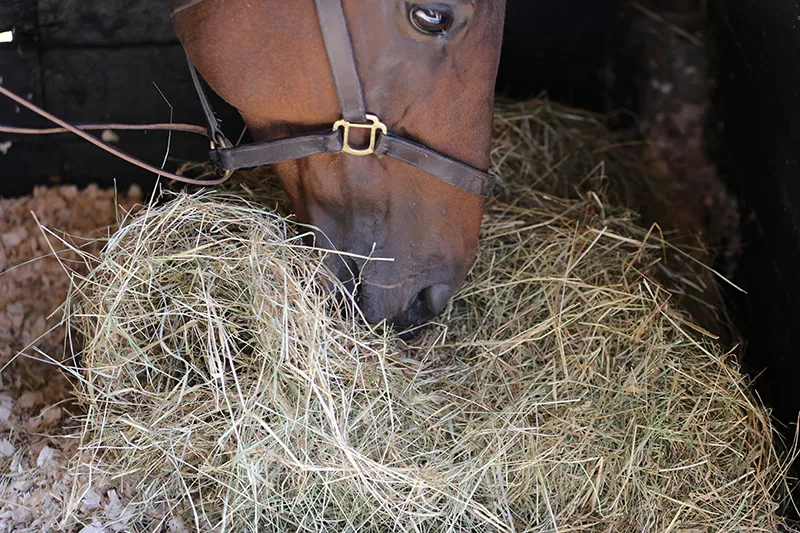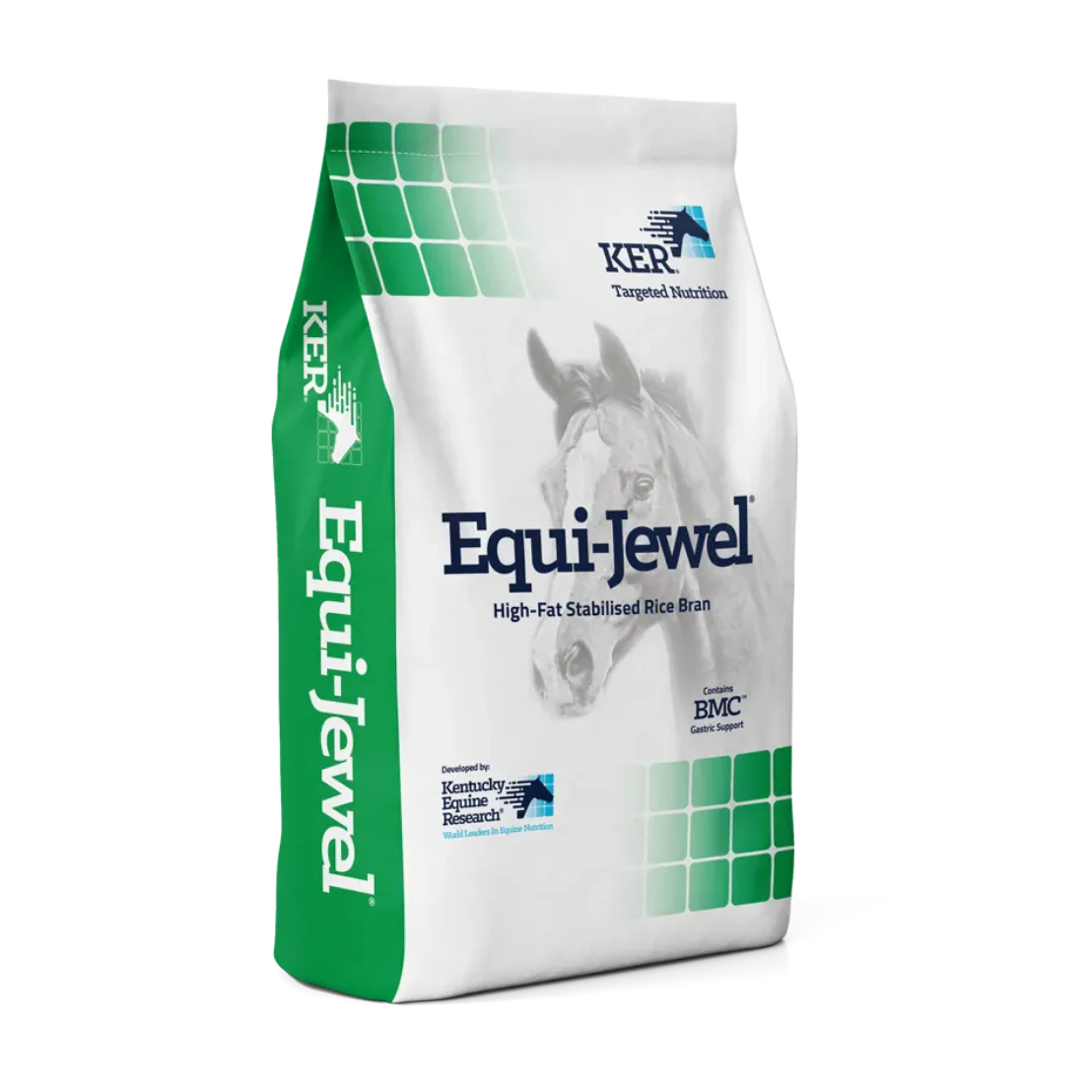Chewing Halters: A New Tool to Track Ingestive Behavior and Optimize Welfare

Chewing Halter and Ingestive Behaviour Studies
Over the last year, Kentucky Equine Research has used chewing halters to record chewing frequency and to analyze the health and welfare of horses by observing behavioral changes during feeding.
The RumiWatch system was originally designed by a Swiss company to track rumination, grazing, standing, and other behaviors of cattle. Once the precision and accuracy of this technology was confirmed, the manufacturer designed a version for horses, called EquiWatch, which passed similar validation trials (Cunningham, 2018; Werner et al., 2020; and Weinert et al., 2020).
According to one research team, “the EquiWatch system can generate data necessary for more fully characterizing feeding behaviors in horses. Data output from the EquiWatch system can be used to determine the specific timing and duration of grazing activity as well as the vigor of pasture forage consumption over a selected interval” (Weinert et al., 2020).
The EquiWatch chewing halter features a sensor that detects pressure changes in an oil-filled tube within the noseband. The sensor is attached to a data logger on the cheekpiece of the halter. The halter also features a battery-powered three–axis accelerometer that detects changes in head position and temperature. All the components are watertight, so the halters can be used in field conditions.
Fitting the halters correctly is important for accurate data collection. The noseband must be adjusted three fingers’ width below the cheekbone and be snug around the muzzle so only two fingers can lie flat between it and the nose bridge.
The halters record data to an SD memory card. Data include time spent eating and the total number of chews, both of which can be split into whether the chewing was performed with the head up or the head down.
In previous studies using the chewing halters, researchers have collected data from horses eating only forage. Scientists at Kentucky Equine Research are now using chewing halters to investigate common feeds used in the management of horses. Chewing halters are fitted on the horses before they are fed a defined amount of feed. Following the completion of the meal, any spilled feed is collected to determine feed intake. From the data collected from the chewing halters, we can calculate variables such as chews per minute, chews per gram of feed intake, and rate of intake. We can compare these variables among feeds with different nutritional compositions, physical form (pellets versus cubes versus textured), and palatability.
Factors that may affect chewing (ingestive behavior) include particle length, elasticity, moisture, flavor, volume, and fracture volume. Animal behavior also plays a role in ingestive behaviors, such as age, preference, condition, previous experience, health status, and temperament.
Chewing starts both chemical and mechanical digestion of feedstuffs due to the production and mixing of saliva and reduction of particle size. Observing and understanding jaw movement can also help researchers better understand how to reduce stomach ulcers as well as assist with dentistry (Werner et al., 2016).
To learn more about the work done at Kentucky Equine Research using chewing halters, read this research abstract: Chewing Requirements and Glycemic Response of Fibrous Feedstuffs.
References:
Cunningham, M. 2018. Validation of the RumiWatch System to measure chewing activity of horses on restricted and ad libitum feeding systems. Thesis, University of Limerick.
Ellis, A.D. 2010. Biological basis of behaviour and feed intake. In: A.D. Ellis, A.C. Longland, M.
Coenen and N. Miraglia. 2010. The impact of nutrition on the health and welfare of horses. EAAP Publication No. 128, Wageningen Academic Publishers, pp. 53-74.
Weinert, J.R., J. Werner, and C.A. Williams. 2020. Validation and implementation of an automated chew sensor–based remote monitoring device as tool for equine grazing research. Journal of Equine Veterinary Science 88:102971.
Werner, J., C. Umstatter, N. Zehner, J.J. Niederhauser, and M. Schick. 2016. Validation of a sensor-based automatic measurement system for monitoring chewing activity in horses. Livestock Science 186:53-58.
This article was written by Molly Todd, a year-long intern at Kentucky Equine Research. As part of the intern program, participants are asked to contribute to Equinews. Learn more about the internship program.
Chewing Requirements and Glycemic Response of Fibrous Feedstuffs
June 9, 2025
Chewing duration is important for optimal horse health and welfare. The saliva produced during chewing buffers stomach acid, and longer chewing times can reduce the risk of boredom and stereotypies. Increased chewing may also result in lower glycemic responses, which could be important for certain horses.
The study objectives were to determine whether there were differences in chewing and glycemic response among fibrous feeds. Five Thoroughbred geldings on a regular dental schedule participated in a 5 × 5 Latin square design over five 7-d periods.
The treatments were soaked beet pulp shreds (BP; 41% NDF; 10.4% NSC; DM basis), fat-and-fiber pellet (FP; 39% NDF; 16% NSC), high-NDF long-stem timothy hay (HTH; 62% NDF; 16.2% NSC), and moderate-NDF long-stem timothy hay (MTH; 52% NDF; 7.6% NSC). Whole oats were included as the fifth treatment for glycemic indexing purposes only; no chewing data were collected for oats.
Horses were fed 500 g of their treatment twice daily. Chewing halters were used to measure the number of chews taken and time spent chewing on d 4–6 of each period (3 observations/horse/period). A glycemic response test was conducted on d 7 over a 6-h period.
Data were analyzed using repeated measures ANOVA, and relationships between chewing and glycemic response variables were measured using simple Pearson correlations. Horses consumed FP the fastest and the 2 hays the slowest, with BP consumed at an intermediate rate (P < 0.05).
The number of chews per minute was lower in the HTH and MTH treatments compared with FP and BP (P < 0.05). Other research has demonstrated that long-stem hay requires larger jaw movements while chewing, which could slow down chewing rate. In addition to a slower chewing rate, the 2 hays and BP also required a greater number of chews per kg of DM compared with FP (P < 0.05), perhaps because the pellets broke apart the most easily during chewing.
Due to differences in NDF among the feeds, chewing was expressed on an NDF basis, and there were no differences among feeds in chews per kg NDF (P > 0.10). Glycemic index was greatest for FP compared with BP and both hays, which were all similar to each other (P < 0.05). There were positive correlations between rate of intake and glycemic index (r = 0.81; P < 0.0001), and chews per minute and glycemic index (r = 0.45; P = 0.05).
There was a negative correlation between glycemic index and chews per kg DM (r = −0.710; P < 0.01). Long-stem hay was chewed slower than smaller particle feeds. However, the amount of chewing per kg NDF is similar, suggesting that fiber content may also play a role in chewing requirements.
Fowler, A.L., C. Guinard, N.A. Imbeault, V.L. Erwin, I.N. Grayston, P. Sweetman, M. Winchester, and J.D. Pagan. 2025. Chewing requirements and glycemic response of fibrous feedstuffs. Journal of Equine Veterinary Science 148:105541.





